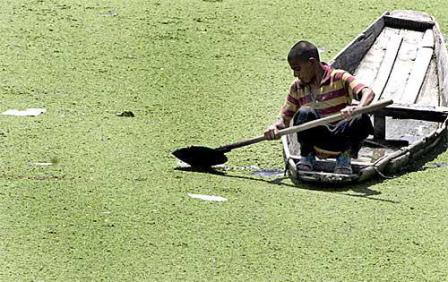SRINAGAR, Aug 2: Kashmir’s famed Dal Lake is meeting a new threat that could jeopardise the population of aquatic species in the water body, environmentalists warn.
An unbridled growth of Azolla has covered many sensitive areas of the lake causing new threats to its already deteriorating eco-system.
“On the basis of scientific tests, I can with surety say that the water fern which has invaded Dal is Azolla Filiculoides. It is one of the most dangerous and obnoxious aquatic water fern encroaching upon every nook and corner,” Kashmir’s noted environmentalist, Dr. Abdul Majeed Kak told a local daily, Greater Kashmir.
He recommends remedial measures on war-footing basis to check its proliferation.
Also Read: Chinese Carp fails to clean Kashmir’s Dal Lake
“Imagine the fate of underwater life, benthos, planktons and other water animals including fishes that receive no light and cannot respire or photosynthesize. Thick mats of Azolla on the surface is fatal for flora and fauna of lakes as it devoid these of sunlight,” Kak says.
Concern about the famous Dal Lake in the scenic region ringed by lofty snow-clad Himalayas is not new. More than a decade ago, red-coloured weeds were seen spreading over the lake which, experts said, were signs of the lake “dying”.
Inside the lake, horticultural plots — known as floating gardens — on the waters have shrunk the lake, from 24 square kilometres in the 1980s to 12 square kilometres.
Also, from five metres a decade ago, it is now only three metres deep, mainly because of plant debris from the floating gardens. Tourist houseboats have proliferated. Untreated human sewage from more than 1500 houseboats and from Srinagar homes is pumped directly into the lake.
During scientific studies in the adjoining Nigeen Lake, Kak says he found an ‘Azolla carpet’ on the surface which was thick at least by 14 inches.
But research is yet inconclusive about how the fern made its way into the lakes. “We are yet to know how Azolla got introduced in our lakes particularly Dal. But there is high concentration of Azolla in Dal catchments from Harwan and its adjoining areas which finally makes its way into Dal,” he said.
“Maybe migratory birds that come to the valley have Azolla seeds in their legs or feathers. However, we can’t rule out human hand in introduction of obnoxious fern in our water bodies.”
The expert says the fern could cause an algal bloom and eutrophication of the Lake if unattended to.
Meanwhile authorities say they are taking measures to deal with the problem.
“We have installed traps on mouth of each channel on Northern Foreshore Road. These are cleaned on a daily basis. Also, wetlands on the mouth of each channel of the lake hold back the solid waste as well as the Azolla,” says vice-chairperson of Lakes and Water ways Development Authority, Irfan Yasin.










